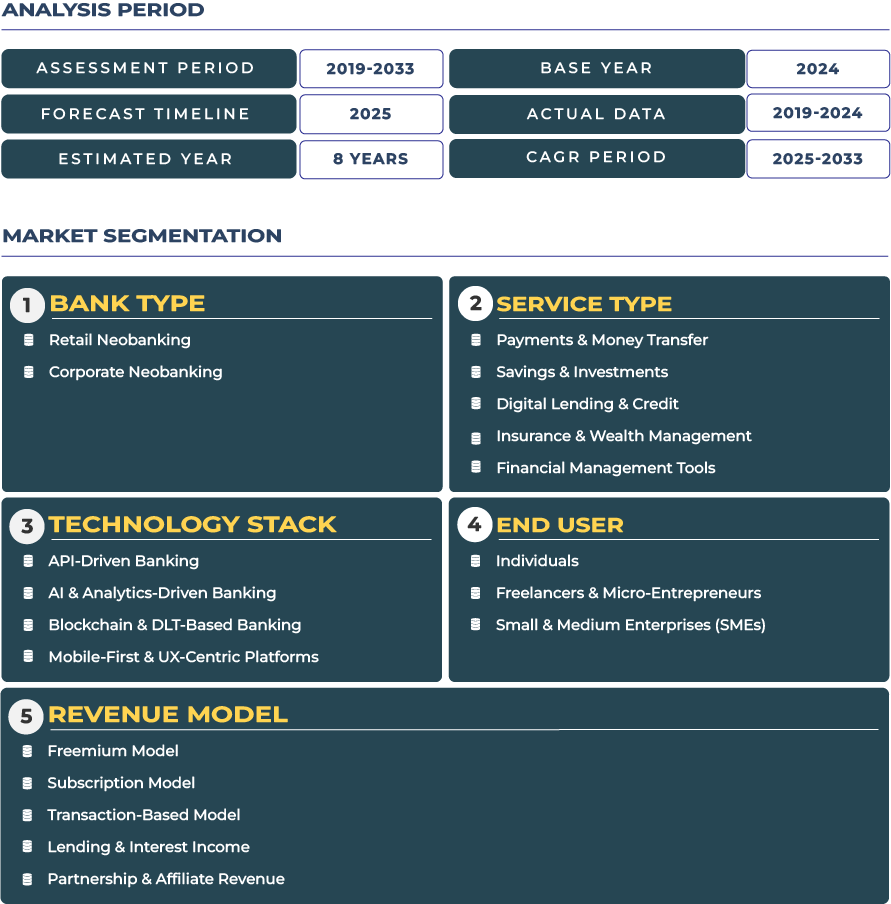Hybrid Digital Adoption & Senior Banking Platforms Drive Japan’s Fintech Neobanking Market
Japan’s shift toward digital banking is defined by a hybrid adoption model that combines high-technology platforms with senior-first user experience (UX) design, compelling technology vendors to deliver modular, licence-agnostic digital-banking stacks that cater to both ageing populations and SMEs. Platform providers are supplying virtual-account cores, wallet modules, vernacular onboarding flows and embedded treasury functions that support senior users, regional SMEs and gig-economy workers. The fintech neobanking market in Japan is projected to reach USD 4,699.8 billion by 2033, driven by vendor-delivered API-first banking modules, mobile-wallet integrations and real-time payment rails. In a market where cash remains influential and demographic shifts challenge digital migration, technology vendors designing low-friction onboarding and multilingual UX are gaining traction. Regulatory reforms under the Financial Services Agency (FSA) and the Bank of Japan’s FinTech Center are increasing openness to embedded-banking modules, open-API-first architectures and bank-agent partnerships. Vendors that can merge high-usability interfaces and enterprise-wallet solutions while aligning with Japan’s high-standards for service-quality, data-protection and system stability are positioned to lead the country’s digital-banking technology ecosystem.
Japan Fintech Neobanking Market: Platform Catalysts, Demographic Tailwinds, and Experience-Centric Digital Banking Strategies
Drivers & Restraints – Real-Time Payment Rails, Senior Digital Literacy, and High UX Standards Define Platform Success
The Japan fintech neobanking market is witnessing steady expansion as platform vendors integrate real-time payment infrastructure such as the Zengin Data Exchange System, enabling 24/7 instant transfer capabilities across embedded and challenger banking platforms. Vendors developing white-label digital-banking stacks for regional institutions and SMEs are benefitting from Japan regulatory encouragement of Open API ecosystems under the Financial Services Agency. Additionally, rising senior digital participation and adoption of smartphone wallets are pushing fintech technology providers to build hybrid interfaces that blend intuitive design with concierge-style digital assistance. Despite this progress, conservative credit frameworks, strict service-quality benchmarks, and data protection regulations act as restraints. Platform vendors face high compliance costs to ensure operational reliability and localization for a risk-averse demographic. The ability to meet these standards while maintaining cost-efficient scalability will determine vendor sustainability in the long term.
Trends & Opportunities – PayPay Ubiquity, Savings Gamification, and Hybrid SME Banking Open New Growth Pathways
Among the most prominent trends shaping Japan fintech neobanking ecosystem is the ubiquity of PayPay and QR-driven wallet adoption, creating opportunities for platform vendors to embed financial services into merchant ecosystems and corporate cash-flow applications. Technology providers are deploying gamified savings interfaces that encourage micro-investments and loyalty-based retention among retail users. In parallel, SME-focused hybrid banking—where digital disbursement modules coexist with physical cash-handling partnerships—has become a growth hotspot. Platform developers are leveraging analytics-driven financial planning and micro-payout engines for SMEs, supporting predictable liquidity across urban centers such as Tokyo, Osaka, and Nagoya. The focus on “sachet banking”—offering compact, feature-rich digital modules tailored to both tech-savvy and senior consumers—exemplifies Japan distinctive neobanking model, blending innovation with cultural trust and user empathy.
Competitive Landscape – Telco Bundles, White-Glove SLAs, and Compliance-First Ecosystem Partnerships Define Vendor Advantage
Japan fintech neobanking landscape is marked by cross-sector collaborations between telecom operators, payment companies, and digital-banking platform providers. Firms like SoftBank (through PayPay) and Rakuten Bank continue to expand platform partnerships offering embedded banking through mobile ecosystems. Technology vendors are differentiating via telco-bundle integrations and “white-glove” service-level agreements (SLAs) that ensure premium experience management, data transparency, and system uptime. These strategies align with Japan service-excellence culture while maintaining regulatory compliance under the Bank of Japan’s oversight. Competitive edge increasingly depends on modular architectures that integrate biometric authentication, low-latency core banking APIs, and context-aware UX optimized for multilingual accessibility.







